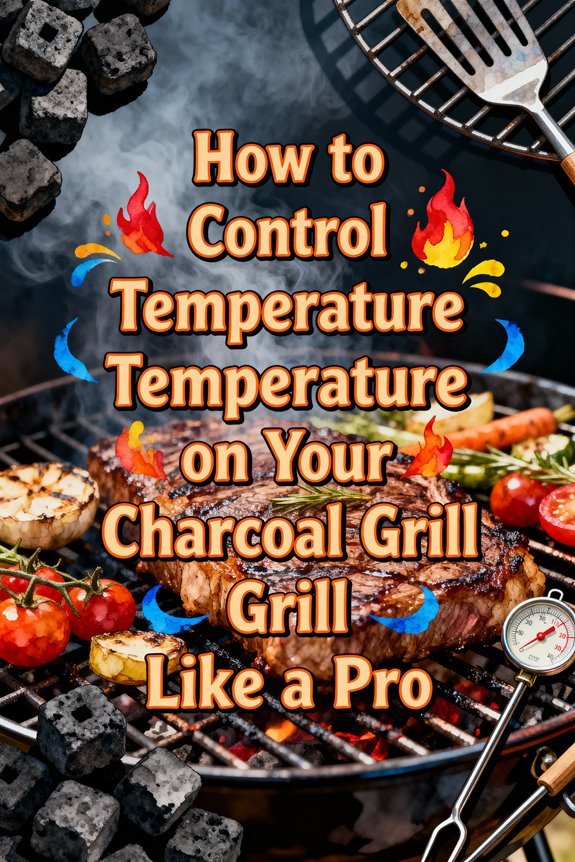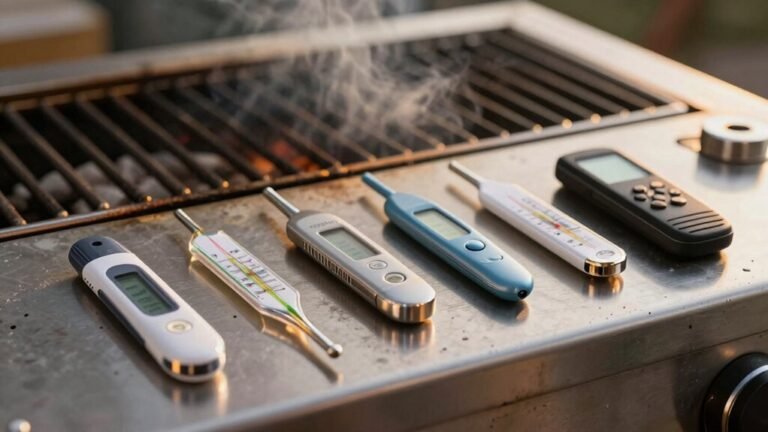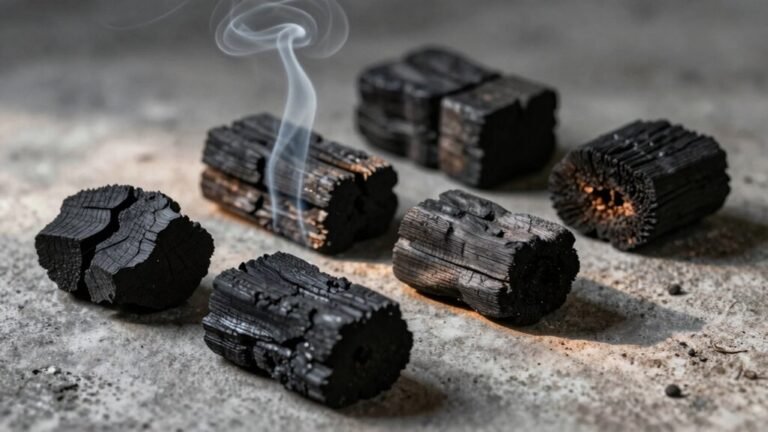You’ll master charcoal grill temperature control by focusing on four essential elements: vent management, fire zones, lid discipline, and fuel placement. Start by creating a two-zone fire setup, then maintain consistent heat by keeping the bottom vent fully open while adjusting the top vent for fine-tuning. Use a digital thermometer for precise monitoring, and minimize lid openings to retain heat. Master these fundamentals, and you’ll reveal the secrets of professional-level grilling techniques.
Understanding Grill Vents and Airflow Management
While mastering your charcoal grill might seem intimidating at first, understanding how vents control airflow is the key to achieving perfect temperatures. Your grill’s intake vents supply oxygen to the fuel, while exhaust vents create a draft that pulls fresh air through the system. This airflow pattern is essential for maintaining steady heat. The exhaust damper remains partially open to prevent smothering the fire with combustion gases. Using a charcoal chimney starter helps establish proper airflow patterns from the beginning of your cook.
You’ll find that intake vent adjustments primarily control your fire’s intensity. Opening both vents fully maximizes oxygen flow and temperature, while closing the intake vent gradually reduces heat by limiting oxygen. For precise temperature control, you’ll want to keep the bottom vent fully open and make subtle vent adjustments to the lid vent. This technique gives you better control over airflow patterns and helps maintain consistent cooking temperatures throughout your grilling session. The radiant heat transfer from burning charcoal embers provides the primary cooking power for your food.
Setting Up Two-Zone Fires for Temperature Control
One of the most effective techniques for controlling temperature on your charcoal grill is setting up a two-zone fire. Create this setup by piling your ashed-over charcoal briquettes on one side of the grill while leaving the other side coal-free. This arrangement gives you a hot zone for direct cooking and a cooler zone for indirect heat. Similar to BBQ ribs which require indirect heat zones for achieving tenderness, this method offers excellent temperature control.
Using a charcoal chimney starter will ensure your coals heat evenly and efficiently before arranging them. The heat gradient between these zones offers remarkable versatility. You’ll sear steaks and burgers on the hot side, then move larger cuts like roasts to the cooler side for gentle cooking. For precise temperature control, adjust your coal quantity and vent positions. Food placement becomes intuitive – shift items between zones to manage cooking speed and prevent flare-ups. Keep the lid closed to maintain stable temperatures, and you’ll master multi-item cooking with ease. Once you’ve mastered your grill’s temperature control, you can even make delicious grilled cheese sandwiches that pair perfectly with tomato soup.
Mastering Charcoal Quantity and Placement
Beyond mastering zone control, success with charcoal grilling depends heavily on managing your fuel. You’ll need to take into account both charcoal sizing and charcoal distribution to maintain your target temperature. Use larger pieces for slower, controlled burns, and smaller pieces when you need quick heat. For steady cooking temperatures, spread your charcoal evenly under the grate, but create a concentrated mound for intense heat zones.
Start with a chimney starter to make certain your coals are properly lit, and don’t hesitate to add pre-lit charcoal gradually during longer cooks. Keep your charcoal bed’s height in mind – the closer it is to your grate, the hotter your cooking surface will be. Keep all grill vents fully open during ignition to ensure optimal airflow. For smoking meats like ham, maintain a low temperature range of 225-250°F for consistent results. Mix lump and briquette charcoal to balance quick heat with sustained burning, and always clear away ash to maintain proper airflow. Monitor your cooking environment carefully using a reliable lid thermometer to ensure consistent temperatures throughout your grilling session.
Essential Lid Management Techniques
Proper lid management stands at the heart of temperature control for charcoal grilling. You’ll achieve ideal heat preservation by keeping your lid closed throughout both preheating and cooking phases. Each time you lift the lid, you’re losing precious heat that takes time to recover, extending your cooking duration and potentially drying out your food.
Make your lid closings count by planning your actions efficiently. When you need to flip food, check doneness, or add fuel, do it all at once rather than opening repeatedly. Your Weber grill’s built-in lid hook makes accessing the cooking area quick and efficient when you do need to open it. For perfect steaks, use the two-zone fire setup with hot coals on one side and cooler space on the other. Just as you’d preheat before cleaning, warm up your grill thoroughly before cooking to ensure optimal temperature control. In challenging weather conditions, especially cold or windy days, maintaining a closed lid becomes even more critical. Remember to use your grill’s vents to fine-tune airflow and temperature instead of relying on lid adjustments alone.
The Role of Grill Maintenance in Temperature Control
While many grillers focus on fuel and airflow techniques, maintaining your charcoal grill’s cleanliness plays an equally essential role in temperature control. Regular grill cleaning prevents ash and grease buildup that can restrict airflow and create erratic temperature swings. You’ll want to empty the ash catcher after each cook and scrub your grates to guarantee proper heat transfer. Setting up a proper two-zone fire helps maintain ideal cooking temperatures across your grilling surface. For optimal cleaning results, heat your grill to 400 degrees Fahrenheit before scrubbing the grates to help loosen stuck-on residue. A vinegar solution soak can help remove stubborn grime that regular brushing doesn’t eliminate.
Make damper inspection part of your routine maintenance. Clean, well-lubricated dampers give you precise control over airflow and temperature. Check for stuck or corroded vents that could compromise your ability to regulate heat. Don’t forget to examine gaskets and seals for wear – any gaps will cause heat loss and make temperature maintenance difficult. This proactive approach prevents sudden equipment failures and guarantees consistent cooking temperatures, especially during long, temperature-sensitive cooks.
Advanced Temperature Zone Strategies
Creating distinct temperature zones on your charcoal grill opens up a world of cooking possibilities, from high-heat searing to low-and-slow smoking. Master multi zone setups by experimenting with proven charcoal techniques like the ring of fire or bull’s-eye method. For advanced heat management, position your coals strategically – create a hot zone for searing and an indirect cooking area for gentler heat. Much like indirect heat cooking is essential for thick cuts like Tomahawk steaks, proper zone control ensures perfect results.
Understanding oxygen supply dynamics helps you master heat control more effectively. You’ll achieve better results through grill experimentation with water pans and vent adjustments. Place a water pan in indirect zones to stabilize temperatures and catch drippings. Fine-tune your bottom and top vents to control oxygen flow, which directly affects coal burn rates. This versatile setup allows you to perfectly grill items like juicy shrimp skewers while simultaneously preparing side dishes. Whether you’re using a two-zone split or a three-zone configuration, these strategies will give you precise control over your cooking temperatures.
Using Temperature Monitoring Tools Effectively
Successful charcoal grilling demands reliable temperature monitoring tools to achieve consistently great results. You’ll find superior results using a dual-channel digital probe thermometer, which tracks both grill ambient temperature and food internal temperature simultaneously. For the most precise readings, insert probes into the thickest part of your meat, avoiding bones and fat. Battery powered probes offer quick and accurate internal temperature checks without a complex setup. When smoking chicken, maintain smoking temperatures between 225°F and 275°F for optimal results.
Modern smartphone integration through Bluetooth thermometers lets you monitor temperatures remotely, with apps that alert you when target temperatures are reached. Remember that regular temperature calibration maintains your tools’ accuracy. While infrared thermometers help identify hot and cold zones on your grill surface, they can’t measure internal meat temperatures. For long cooks, rely on leave-in probes to maintain consistent heat without repeatedly opening the lid and losing precious temperature control. A 20-30 minute preheat with white-hot coals ensures your grill reaches proper cooking temperatures before adding food.
Common Temperature Control Troubleshooting
When temperature control issues arise on your charcoal grill, systematic troubleshooting can quickly identify and resolve common problems. Start by checking for air leaks around your grill’s lid and doors – these unwanted gaps can disrupt oxygen flow and heat retention. Seal any leaks you find with food-safe silicone or gaskets to improve temperature stability. Consider installing a digital thermometer for accurate temperature monitoring throughout your cook. Regular grate cleaning helps ensure consistent heat distribution and prevents flare-ups from stuck-on residue.
Next, evaluate your fuel timing and placement. If you’re experiencing temperature drops, don’t wait too long to add fresh charcoal. Create a two-zone setup with your coals for better control, and verify they’re evenly spread to prevent hot spots. Pay attention to your damper adjustments, particularly the exhaust vent, as it greatly impacts draft control. When finished cooking, close all vents to extinguish coals safely by cutting off oxygen flow. In windy conditions, use windbreaks to maintain steady airflow and consistent cooking temperatures.







